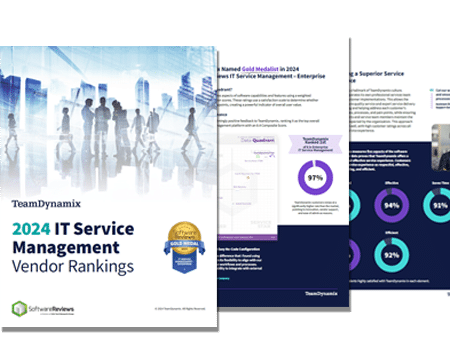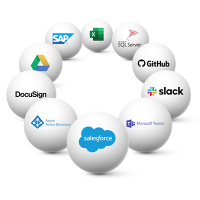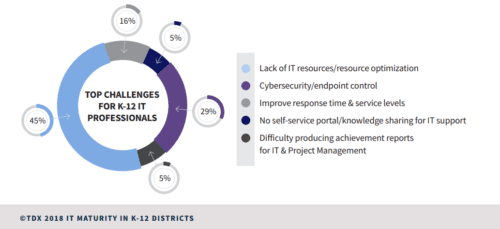
The Benefits of Using Project Portfolio Management Organization-Wide
Project Portfolio Management (PPM) is a powerful tool that businesses and organizations can use to manage and optimize projects. PPM enables companies to have a

The Info-Tech ranking report offers a unique view of the market based entirely on in-depth customer interviews. Download the Info-Tech ITSM Quadrant and Customer Viewpoint report today.

We’ll show you some of our best situations and show you exactly how to execute them to get immediate results. The best part is, iPaaS tools often feature easy-to-use click and drag functionality, meaning you don’t need a dedicated employee building integrations and workflows.

System Integrators, Value Added Resellers, Technology Providers, and Buying Consortiums can benefit from a partnership with TeamDynamix.

The Info-Tech ranking report offers a unique view of the market based entirely on in-depth customer interviews. Download the Info-Tech ITSM Quadrant and Customer Viewpoint report to gain a better understanding of key vendor strengths and emerging market requirements.
As organizations grow and evolve, managing multiple projects simultaneously becomes increasingly challenging. Enter Project Portfolio Management (PPM), a strategic approach that helps organizations prioritize, execute, and monitor projects more effectively. In this blog post, we’ll explore the key advantages of PPM and how it can revolutionize the way your organization handles its projects.
By adopting Project Portfolio Management, you can streamline project delivery, improve transparency, support better decision-making and enhance collaboration between different teams.
To fully harness the potential of PPM, it’s essential to understand its various stages and how they contribute to overall success. In this section, we’ll delve into the five primary stages of PPM and offer insights into each step.
The first stage in PPM involves identifying and aligning projects with organizational goals and objectives. This process requires a clear understanding of your organization’s strategic vision and priorities. By defining the project portfolio in line with these objectives, you can ensure that all projects contribute to achieving your organization’s long-term goals.
Once you’ve established your project portfolio, the next step is to evaluate each project based on strategic fit, risk and potential return on investment (ROI). This analysis helps you identify the projects that are most likely to deliver the desired outcomes and provide the highest value for your organization. Portfolio analysis also allows you to assess the risks associated with each project, enabling you to make informed decisions about resource allocation and risk mitigation strategies.
With a thorough understanding of each project’s strategic fit, risk and potential ROI, you can now prioritize projects according to their importance. This stage involves ranking projects based on their alignment with organizational objectives and their potential impact on the organization’s bottom line. By prioritizing projects in this way, you can allocate resources more effectively, ensuring that high-priority projects receive the attention and support they need to succeed.
During the portfolio execution stage, the focus shifts from planning to action. This phase involves monitoring project progress, managing risks and ensuring successful project delivery. Effective portfolio execution requires robust project management practices, clear communication channels and strong collaboration among team members. By closely monitoring progress and addressing any issues that arise, you can keep projects on track and ensure they achieve their intended outcomes.
The final stage of PPM is the portfolio review, which involves assessing project performance, capturing lessons learned and making adjustments as needed. This stage is crucial for continuous improvement and helps organizations refine their project management processes over time. By regularly reviewing project performance and incorporating lessons learned into future initiatives, you can optimize your project portfolio management approach and drive ongoing success.
So how can you measure the success of your PPM efforts? There are a few key metrics you can look at, those include:
Project Portfolio Management offers a multitude of advantages for organizations looking to optimize their project management processes. By streamlining project delivery, improving transparency, supporting better decision-making and enhancing collaboration, PPM can revolutionize the way your organization handles its projects.
If you’re ready to unlock the full potential of your project portfolio, it’s time to consider implementing a PPM strategy. To learn more about PPM, visit www.teamdynamix.com/project-portfolio-management.

Project Portfolio Management (PPM) is a powerful tool that businesses and organizations can use to manage and optimize projects. PPM enables companies to have a

Project Management in Higher Education Anyone who has been on this earth over the last 4-6 weeks has abruptly learned a few key lessons, and

Lack of Resources in K-12 Districts Grow As districts range in size and scope one thing has remained a constant for K-12 Districts, they are
TeamDynamix’s award-winning SaaS cloud solution offers IT Service and Project Management together on one platform with enterprise integration and automation.
[email protected]
(877) 752-6196
Contact Us
